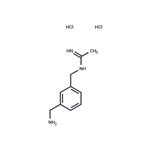Description
1400W (214358-33-5) is a potent, tight-binding, slow inhibitor of inducible nitric oxide synthase (iNOS). Highly selective for iNOS3?(Ki?= 7 nM) over nNOS or eNOS (Ki‘s of 2 μM and 50 μM respectively).1?1400W is cell permeable and active?in vivo.2
Chemical Properties
white to off-white powder
Uses
1400W dihydrochloride has been used:
- as a strong inhibitor of inducible nitric oxide to analyse its effect on intestinal ischemia/reperfusion (I/R) injury model in rat
- as inducible nitric oxide synthase (iNOS)-selective inhibitor, to elucidate the mechanism of PM10-induced endothelial dysfunction
- to study its efficacy on renal ischemia/ reperfusion injury in rats
- as iNOS inhibitor to investigate its ability to counteract spatial memory deficits after hypobaric hypoxia reoxygenation
Uses
A selective inducible nitric oxide synthase (iNOS) inhibitor. A long-acting human iNOS inhibitor possessing an IC50 value of 2.0uM.
General Description
A selective, cell-permeable, irreversible, slow, tight-binding inhibitor of inducible nitric oxide synthase (iNOS; K
d = 7 nM). Suitable for use in both
in vitro and
in vivo systems. Has a protective effect against cerebral ischemia by reducing ischemic lesion volumes. Exhibits greater than 5000- and 200-fold potency against human iNOS relative to eNOS and nNOS, respectively, and greater than 1000-fold potency against rat iNOS relative to eNOS.
Biochem/physiol Actions
Cell permeable: yes
References
References/Citations
1) Garvey?et al. (1997),?1400W is a slow, tight-binding, and highly selective inhibitor of inducible nitric-oxide synthase in vitro and in vivo; J. Biol. Chem.,?272?4959
2) Thomsen?et al. (1997),?Selective inhibition of inducible nitric oxide synthase inhibits tumor growth in vivo: Studies with 1400W, a novel inhibitor; Cancer Res.,?57?3300
3) Pigott?et al. (2013),?On the selectivity of neuronal NOS inhibitors; Br. J. Pharmacol.,?168?1255

